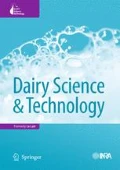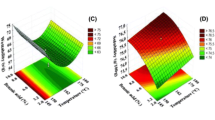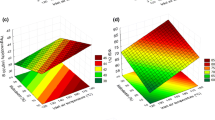Abstract
The aim of this study was to elucidate the factors affecting the dispersibility and morphology of soy powders. The influences of the configuration of a spraying system (CSS) on particle size and dispersibility of soy powders were investigated. The dispersibility, morphology, and particle sizes of powders produced using a wheel and those obtained using a nozzle differed. A moderate increase in particle size (from 15 to 24 μm) improved powder dispersibility in most cases. At a total protein content in the powder (w/w%)/total solids in the concentrate (w/w%) ratio of between 30/20 and 35/20, using the wheel significantly increased particle size (from 23 to 40 μm) in comparison to nozzle (from 14 to 20 μm); moreover, this increase in particle size was correlated to increase in dispersibility (r 2 = 0.90). These results are in agreement with published findings showing that a surface area that is too large (small particles) can lead to poor dispersibility of a powder in the case of both whey protein and micellar casein. In addition, the wheel provided a smaller span of particle sizes than the nozzle. The powders obtained with the wheel were therefore more homogeneous than those produced with the nozzle, making them easier to characterize in terms of functional properties. In summary, the dispersibility of soy powders depends on CSS with the wheel providing the most dispersible particles.





Similar content being viewed by others
Abbreviations
- CSS:
-
Configuration of the spraying system
- DE:
-
Dextrose equivalent
- DI:
-
Dispersibility index
- IA:
-
Interstitial air
- OAT :
-
Occluded air
- MD:
-
Maltodextrin
- MMD:
-
Mobile minor dryer
- SSFR:
-
Soy supreme fiber reduced
- Span:
-
Variation coefficient
- TP:
-
Total protein
- TS:
-
Total solid
- a w :
-
Water activity
- d 0.5 :
-
Mass median diameter 50% of the distribution is above and 50% is below
- d 0.1 :
-
10% of the volume distribution is below this value
- d 0.9 :
-
90% of the volume distribution is below this value
- ρ B :
-
Bulk density
- ρ T :
-
Tapped density
- ρ TR :
-
True density
References
Adhikari B, Howes T, Bhandari BR, Truong V (2003) Characterization of the surface stickiness of fructose–maltodextrin solutions during drying. Dry Technol 21:17–34
Bhandari BR, Senoussi A, Dumoulin ED, Lebert A (1993) Spray drying of concentrated fruit juices. Dry Technol 11:1081–1092
Carp DJ, Wagner GB, Bartholomai GB, Pilosof AMR (1997) Rheological method for kinetics of drainage and disproportionation of soy proteins foams. J Food Sci 62:1105–1109
Dacanal GC, Menegalli FC (2010) Selection of operational parameters for the production of instant soy protein isolate by pulsed fluid bed agglomeration. Powder Technol 203:565–573
Depreter F, Amighi K (2010) Formulation and in vitro evaluation of highly dispersive insulin dry powder. Eur J Pharm Biopharm 76:454–463
Favaro-Trindade CS, Santana AS, Monterrey-Quintero ES, Trindade MA, Netto FM (2010) The use of spray drying technology to reduce bitter taste of casein hydrolysate. Food Hydrocolloids 24:336–340
Gupta AS (1978) Spray drying orange juice. US Patent n° US4112130 (A)
Hino T, Shimabayashi S, Ohnishi N, Fujisaki M, Mori H, Watanabe O, Kawashima K, Nagao K (2000) Development of a new type nozzle and spray-drier for industrial production of fine powders. Eur J Pharm Biopharm 49:79–85
Imram N, Gomez I, Soh V (2003) In: Imram N (ed) The soya handbook. Tetra Pak Centre of Expertise Soya, Singapore
Kim SH, Kinsella JE (1987a) Surface active properties of food proteins: effects of reduction of disulfide bonds on film properties and foams stability of glycinin. J Food Sci 52:128–131
Kim SH, Kinsella JE (1987b) Surface active properties of proteins: effects of progressive succinylation on film properties and foams stability of glycinin. J Food Sci 52:1341–1352
Kinsella JE (1979) Functional properties of soy proteins. J Am Oil Chem Soc 56:242–258
Langrish TAG, Chan WC, Kota K (2007) Comparison of maltodextrin and skim milk wall deposition rates in a pilot-scale spray dryer. Powder Technol 179:84–89
Nakamura A, Yoshidab R, Maedab H, Corredig M (2006) Soy soluble polysaccharide stabilization at oil–water interfaces. Food Hydrocolloids 20:277–283
Nazareth ZM, Deak NA, Johnson LA (2009) Functional properties of soy protein isolates prepared from gas-supported screw-pressed soybean meal. J Am Oil Chem Soc 86:315–321
Roos YH, Karel M (1991a) Plasticizing effect of water on thermal behaviour and crystallization of amorphous food models. J Food Sci 56:38–43
Roos YH, Karel M (1991b) Water and molecular weight effects on glass transitions in amorphous carbohydrates and carbohydrate solutions. J Food Sci 56:1676–1681
Rosenberg M, Kopelman IJ, Talmon Y (1985) A scanning electron microscopy study of microencapsulation. J Food Sci 50:139–144
Schuck P, Bouhallab S, Durupt D, Vareille P, Humbert JP, Marin M (2004) Séchage des lactosérums et dérivés: rôle du lactose et de la dynamique de l'eau. Lait 84:243–268
Schuck P, Méjean S, Dolivet A, Jeantet R, Bhandari B (2007) Keeping quality of dairy ingredients. Lait 87:481–488
Schuck P, Dolivet A, Jeantet R (2012) Analytical methods for food and dairy powders. Wiley, Hoboken
Ting TY, Gonda I, Gipps EM (1992) Microparticles of polyvinyl alcohol for nasal delivery. I. Generation by spray-drying and spray-desolvation. Pharm Res 9:1330–1335
Tonon RV, Baroni AF, Brabet C, Gibert O, Pallet D, Hubinger M (2009) Water sorption and glass transition temperature of spray dried. açai (Euterpe oleracea Mart.) juice. J Food Eng 94:215–221
Turchiuli C, Jimenèz T, Dumoulin E (2011) Identification of thermal zones and population balance modelling of fluidized bed spray granulation. Powder Technol 208:542–552
Wagner JR, Gueguen J (1999) Surface functional properties of native, acid treated, and reduced soy glycinin. 1. Foaming properties. J Agric Food Chem 47:2173–2187
Acknowledgments
The authors would like to thank Peter Nootenboom and Patricia Heussen (Unilever) for the scanning electron micrograph images.
This research was supported by Unilever (R&D Vlaardingen, Netherlands).
Author information
Authors and Affiliations
Corresponding author
About this article
Cite this article
Syll, O., Khalloufi, S. & Schuck, P. Dispersibility and morphology of spray-dried soy powders depending on the spraying system. Dairy Sci. & Technol. 93, 431–442 (2013). https://doi.org/10.1007/s13594-013-0112-y
Received:
Revised:
Accepted:
Published:
Issue Date:
DOI: https://doi.org/10.1007/s13594-013-0112-y




